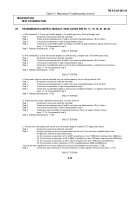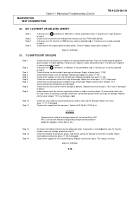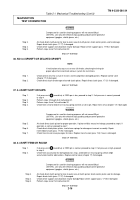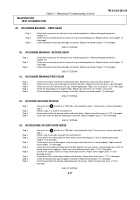TM-9-2320-280-34 - Page 49 of 1258
TM 9-2320-280-34
Table 2-3. Air Conditioning Troubleshooting (Cont ’d)
MALFUNCTION
TEST OR INSPECTION
28.
TRANSMISSION NOISY
AIR-CONDITIONER
1.
INSUFFICIENT COOLING
a.
Check for Refrigerant Loss
Step 1.
Connect manifold gauge to low and high service connectors (para. 14-17).
Step 2.
Start vehicle engine and adjust speed to 1500 rpm (TM 9-2320-280-20).
Step 3.
Set thermostat switch and fan switch to maximum position (TM 9-2320-280-10).
Step 4.
Run vehicle with air-conditioner on for five minutes.
Step 5.
Check low side of manifold gauge for normal to low reading and high side for low reading (table 2-2). If these
conditions occur, perform leak test, repair leaks, evacuate, and recharge as necessary (para. 14-17).
b.
Check for Air or Moisture in System
Step 1.
Perform malfunction 1a, steps 1 through 4.
Step 2.
Check low side of manifold gauge for normal to high reading (table 2-2). If sight glass has no bubbles, tiny
bubbles, or occasional bubbles, discharge system, replace dryer bottle (para. 14-19), evacuate, and recharge
system (para. 14-17).
c.
Check Expansion Valve
Step 1.
Perform malfunction 1a, steps 1 through 4.
Step 2.
Check high side of manifold gauge for high reading and low side for low reading (possible vacuum) (table 2-
2). If discharge (evaporator) air is cool, expansion valve sweating or frosted, or control tube loose, either
reposition control tube or replace expansion valve (para. 14-21).
NOTE
If control tube must be repositioned, re-wrap bulb with insulating tape.
Step 3.
Check high side of manifold gauge for high reading and low side for high reading (table 2-2). If discharge
(evaporator) air is warm, replace expansion valve (para. 14-21).
d.
Check Thermostatic Switch
Step 1.
Perform malfunction 1a, steps 1 through 4.
Step 2.
Check low and high side manifold gauge readings for normal reading (table 2-2). If system runs
continuously, remains in on (evaporator freeze-up) or off (poor cooling) cycle, or is inoperative, but can be
made operative by jumping battery to clutch power load wire, then relocate temperature sensor, perform
electrical troubleshooting (TM 9-2320-280-20) or replace thermostat unit, as necessary (para. 14-15).
e.
Check Clutch Cycling Pressure Switch
Step 1.
Perform malfunction 1a, steps 1 through 4.
Step 2.
Check low side of manifold gauge for low reading and high side for normal reading (table 2-2). If clutch
cycling system runs continuously, then the switch is stuck closed. Replace pressure switch (para 14-16).
Step 3.
Check low and high side of manifold gauge for an approximate 70 psi (483
kPa) reading. If system is
inoperative, but can be made operative by jumping battery to clutch power lead wire, then the switch is
stuck open. Replace pressure switch (para. 14-16).
2-22
Back to Top




















